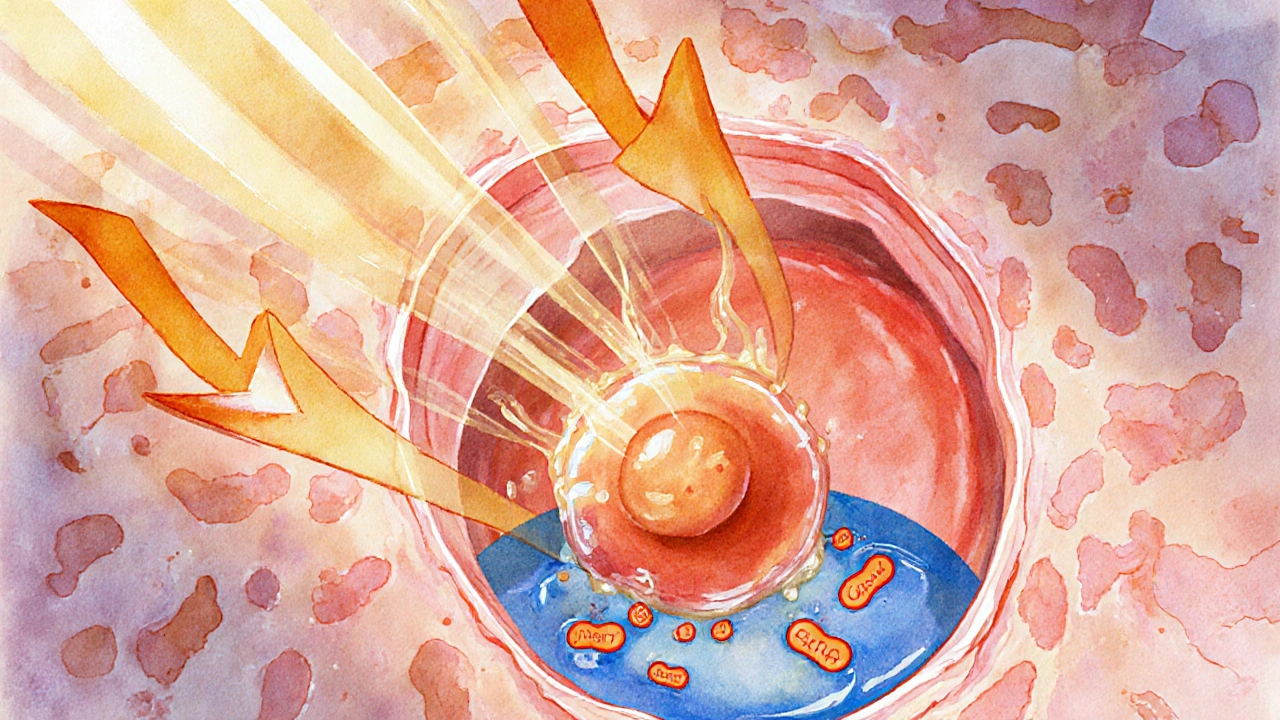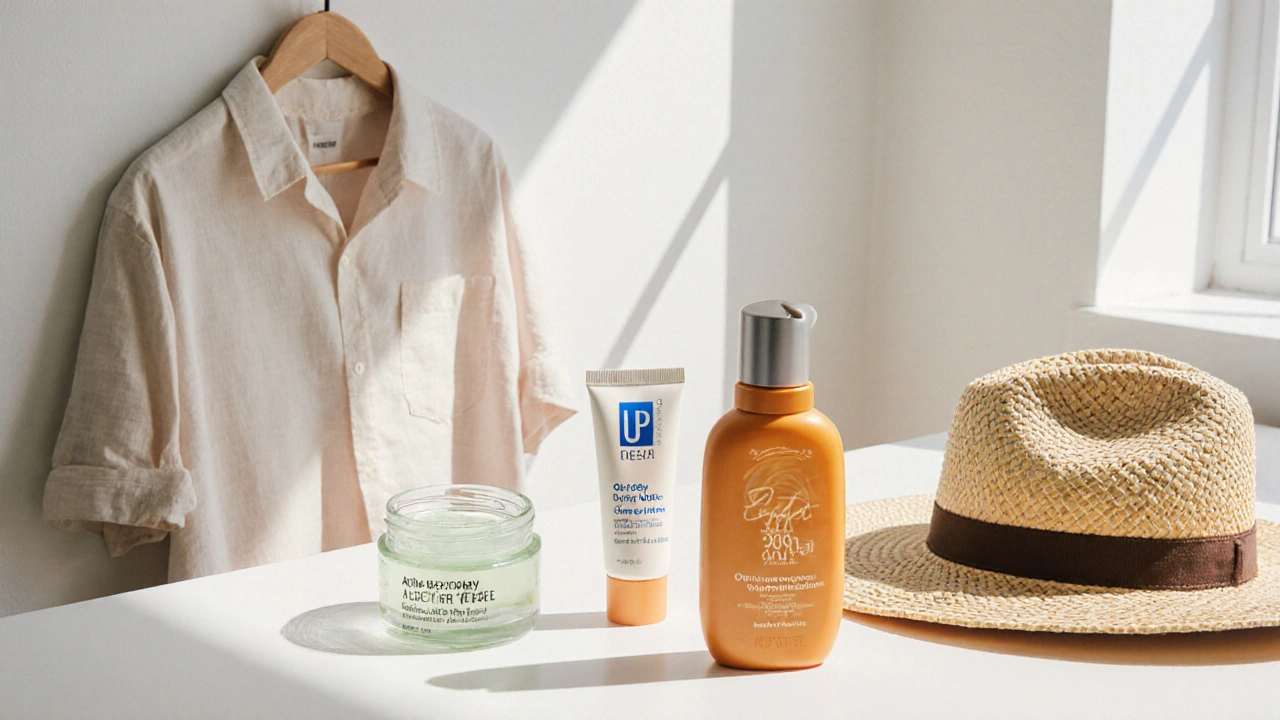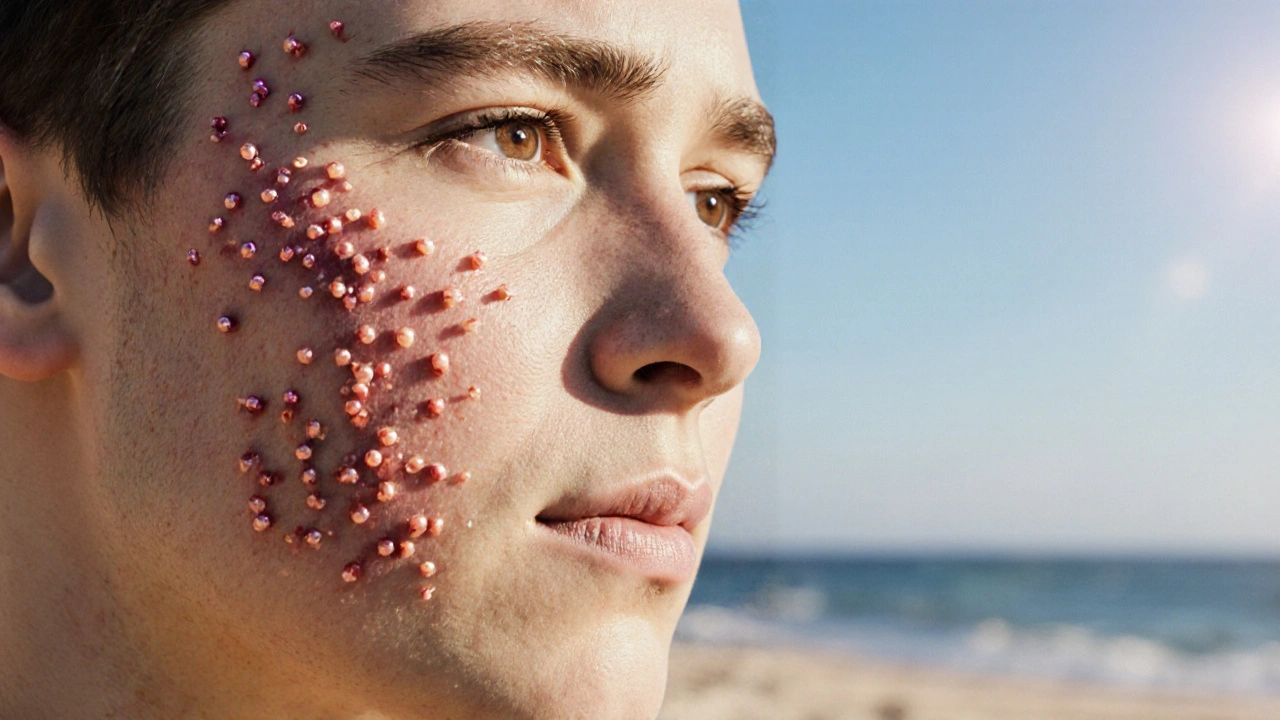Sunburn & Acne Risk Assessment Tool
Assess Your Sunburn & Acne Risk
How much sun exposure do you have? What's your skin type? Find out your risk level and get personalized care recommendations.
Your Sun Exposure Details
Your Skin Profile
Your Personalized Results
Risk Level
Recommendations
If you’ve ever wondered how sunburn affects acne, keep reading. A day in the sun can leave you with painful red patches, but it can also stir up unwanted pimples. Understanding why this happens and how to treat both issues saves you from endless trial and error.
Below we break down what sunburn and acne actually are, how they interact, and the steps you can take to soothe the burn while keeping your skin clear.
What Is Sunburn?
Sunburn is an acute injury to the skin caused by excessive exposure to ultraviolet (UV) radiation. UV rays are split into UVA (aging rays) and UVB (burning rays). UVB carries most of the energy that damages the DNA in skin cells, leading to redness, swelling, and even blistering within hours.
The outermost layer, the epidermis, bears the brunt of the damage. When the skin’s protective melanin can’t absorb enough UV, blood vessels dilate, causing that classic pink‑red hue. Common symptoms include tenderness, heat, and in severe cases, peeling that can last days.
What Is Acne?
Acne is a chronic inflammatory condition of the pilosebaceous unit that results in comedones, papules, pustules, and sometimes cysts. Hormonal fluctuations, excess sebum production, clogged pores, and the bacteria Cutibacterium acnes all play a part.
When a hair follicle fills with oily sebum, dead skin cells can’t shed properly, creating a plug. Bacteria feed on this plug, releasing enzymes that trigger inflammation. The end result may be a lingering spot or a painful nodule.

How Sunburn Can Trigger Acne Breakouts
Even though they seem unrelated, sunburn can set off a cascade that fuels acne. First, the intense inflammation from UV damage releases cytokines-messenger proteins that increase blood flow and attract immune cells. This heightened inflammatory environment can make existing clogged pores swell, turning a quiet spot into a red bump.
Second, the skin barrier-our protective outer shield-gets compromised by UV radiation. When the barrier weakens, it loses its ability to retain moisture and keep irritants out. A leaky barrier encourages excess sebum (the oily substance produced by Sebum is a waxy mixture of lipids secreted by sebaceous glands to lubricate the skin) to pool on the surface, creating the perfect breeding ground for bacteria.
Lastly, UV exposure can increase the production of reactive oxygen species (ROS). These free radicals further damage skin cells, prompting the body to produce more inflammatory mediators, which again can aggravate acne.
Managing Sunburn to Prevent Acne
Quick, gentle care is key. The first 24hours after a burn, focus on cooling and hydration rather than heavy lotions that might clog pores.
- Apply a thin layer of aloe vera gel or a fragrance‑free, non‑comedogenic moisturizer. Look for ingredients like glycerin and hyaluronic acid that lock in water without blocking pores.
- Use a Broad-spectrum sunscreen is a sunscreen that protects against both UVA and UVB rays once the skin has cooled. Choose formulas labeled “oil‑free” or “for acne‑prone skin.” Apply at least 2mg/cm² (about a teaspoon for the face) and reapply every two hours.
- Wear protective clothing-wide‑brimmed hats, UPF shirts, and sunglasses-to limit further UV exposure.
Avoid picking at blisters or peeling skin. Picking can introduce bacteria deeper into the follicle, sparking a breakout that lasts weeks.
Treating Acne After Sun Exposure
If a breakout does appear, treat it with acne‑friendly actives that won’t irritate sun‑sensitive skin.
- Benzoyl peroxide: Kills acne‑causing bacteria without needing harsh scrubs. Start with a 2.5% concentration to avoid extra irritation.
- Salicylic acid: Exfoliates inside the pore, helping to dissolve the sebum plug. A 0.5-1% serum applied at night works well.
- Retinoids: Promote cell turnover and strengthen the barrier. Choose a low‑dose, over‑the‑counter retinol and introduce it slowly (every other night) after the sunburn has healed.
- Spot‑treat with a silicone‑based gel that forms a breathable barrier, protecting the pimple from external irritants while it heals.
Never combine multiple strong actives on the same day; the skin can become overly irritated, undoing the benefits of both sunburn recovery and acne control.

Prevention Checklist: Keep Sunburn and Acne Separate
- Apply Broad-spectrum sunscreen every morning, even on cloudy days.
- Choose non‑comedogenic moisturizers and makeup.
- Stay hydrated; water helps the skin repair the barrier faster.
- Limit peak sun exposure (10am-4pm) and seek shade when possible.
- Cleanse gently twice a day with a pH‑balanced cleanser; avoid scrubbing.
- Incorporate antioxidant‑rich foods (berries, leafy greens) to combat ROS.
- Track flare‑ups in a skin journal to spot patterns linked to sun exposure.
Sunburn vs. Acne: Quick Comparison
| Aspect | Sunburn | Acne |
|---|---|---|
| Primary cause | Excessive UV radiation | Hormonal sebum overproduction & bacterial growth |
| Typical appearance | Red, warm, sometimes blistered skin | Whiteheads, blackheads, papules, pustules |
| Immediate treatment | Cool compresses, aloe, hydration | Topical benzoyl peroxide, salicylic acid |
| Long‑term care | Broad‑spectrum sunscreen, barrier repair | Consistent skin‑care routine, occasional retinoids |
Frequently Asked Questions
Can sunburn cause new pimples?
Yes. The inflammation and barrier damage from a burn create an environment where clogged pores become inflamed, turning into pimples.
Should I skip sunscreen if I have acne?
No. Choose a non‑comedogenic, oil‑free sunscreen. Protecting your skin from UV damage also helps prevent post‑sun breakouts.
Is it safe to use retinoids after a sunburn?
Wait until the sunburn has fully healed (usually 5‑7 days) before re‑introducing retinoids. Applying them too soon can cause severe irritation.
What ingredients should I avoid on sun‑burned, acne‑prone skin?
Stay away from heavy oils, fragrances, alcohol‑based toners, and high‑concentration acids (AHA >10%). They can further compromise the skin barrier.
How long does it take for a sunburn‑related breakout to clear?
Most post‑sun breakouts fade within 7‑10 days with proper care. Persistent lesions may need a short course of topical antibiotics.
By treating sunburn promptly, protecting the skin barrier, and using acne‑friendly products, you can keep both issues at bay. Remember: a little sunscreen and a gentle routine go a long way toward clear, healthy skin.

20 Comments
Madison MaloneOctober 15, 2025 AT 21:30
I used to think sunburn helped my acne until I got burned bad last summer and woke up with a whole new crop of angry red bumps. Turns out, heat and UV just make everything worse. Now I stick to aloe and gentle moisturizers-no more guessing games.
My skin’s been so much calmer since I stopped chasing that ‘sun-kissed glow’ myth.
Graham Moyer-StrattonOctober 16, 2025 AT 18:25
Sunburn causes acne? Nah. You just got lazy with your skincare. Stop blaming the sun and start washing your face.
tom charltonOctober 18, 2025 AT 03:33
The scientific basis presented here is both accurate and clinically relevant. Sun-induced inflammation significantly alters the cutaneous microbiome and compromises stratum corneum integrity, thereby facilitating the proliferation of Cutibacterium acnes and subsequent comedogenesis.
It is imperative that individuals with acne-prone skin adopt a regimen grounded in evidence-based dermatological principles, including daily broad-spectrum photoprotection and the avoidance of occlusive agents.
Jacob Hepworth-wainOctober 18, 2025 AT 11:00
Biggest mistake I made? Thinking sunscreen made my acne worse. I switched to a non-comedogenic one and my skin actually cleared up. No more hiding behind hats.
Just keep it simple. Cleanse, moisturize, protect. That’s it.
king tekken 6October 18, 2025 AT 11:25
you know what they dont tell you about sunburn and acne? its all the chemicals in sunscreen that clog your pores not the sun itself. the government wants you to buy expensive lotions so they can profit. real skin care is just water and patience. i stopped using sunscreen and my face got better. no joke. try it. they dont want you to know this
DIVYA YADAVOctober 19, 2025 AT 15:03
This is all propaganda from Big Pharma and Western cosmetic corporations trying to sell you overpriced gels and sunscreens while hiding the truth-sun exposure is natural and heals everything. In India, we’ve been using turmeric and neem for centuries without any of this nonsense. Why are you letting corporations dictate how your skin should look? They profit from your fear. Sunburn is just your body rejecting poison. Let it breathe. Stop trusting Western science. Trust nature. Trust tradition. Trust your ancestors. They didn’t have SPF 50 and they had flawless skin.
Kim ClapperOctober 19, 2025 AT 23:34
Actually, this article is dangerously misleading. You’re encouraging people to use ‘non-comedogenic’ products, but there is no FDA-regulated definition of that term. It’s a marketing buzzword. The entire skincare industry is built on pseudoscience and emotional manipulation. You’re not helping people-you’re enabling consumerism disguised as self-care.
Bruce HennenOctober 21, 2025 AT 15:02
Incorrect usage of ‘sebum’ as a noun in the phrase ‘Sebum is a waxy mixture’-it’s a collective noun and should not be capitalized. Also, ‘broad-spectrum sunscreen is a sunscreen’ is redundant and grammatically flawed. This article reads like a poorly edited blog post masquerading as medical advice.
Jake RuhlOctober 23, 2025 AT 00:59
so i was at the beach last week and i got this crazy sunburn and then i woke up with like 15 pimples and i was like wow this is wild right? but then i started thinking… what if the sun is actually trying to tell us something? like maybe our skin is screaming for detox? maybe all these products are poisoning us? i stopped washing my face with soap and just rinsed with water and guess what? my skin started glowing. no joke. the system is broken. they want you scared. they want you buying stuff. but the truth is… the sun is the real healer. listen to your skin not the ads
Chuckie ParkerOctober 24, 2025 AT 00:47
If you're getting acne from sunburn you're not using the right sunscreen. You're probably using some cheap drugstore crap with coconut oil in it. Real men use zinc oxide. Real men don't whine about breakouts. You want clear skin? Use what works. Stop listening to influencers.
Michael SegbawuOctober 25, 2025 AT 12:30
sunburn causes acne? nah its just your face crying because you forgot to wash it after sweating at the beach. everyone knows you gotta rinse off after sun. if you dont thats your fault not the suns fault. i dont need no aloe or fancy gels. cold water and a towel thats it. simple. real simple
Michelle N AllenOctober 26, 2025 AT 22:03
Why does this even need an article? Sunburn irritates skin. Irritated skin breaks out. That’s biology 101. I don’t need a 2000-word essay to tell me to use sunscreen. Just do it.
Craig HartelOctober 28, 2025 AT 13:14
I’m from rural Kansas and we never had fancy skincare growing up. We used lard and honey for everything. After a long day in the fields, I’d wash my face with cool water and put on a little honey-it worked better than anything I’ve bought since. Maybe we don’t need all these ingredients. Sometimes the oldest remedies are the quietest heroes.
Chris KahanicOctober 28, 2025 AT 23:26
Well-researched. The connection between UV-induced oxidative stress and acne exacerbation is under-discussed in mainstream media. The inclusion of ROS and barrier dysfunction is particularly valuable. I’ve seen this pattern in clinical practice-patients often overlook sun exposure as a trigger.
Geethu EOctober 29, 2025 AT 12:54
I used to get awful breakouts after beach trips until I started using aloe vera from my own plant. It’s free, natural, and doesn’t clog pores. Also, drinking coconut water helps your skin recover faster. I’m from Kerala-we’ve known this for generations. You don’t need expensive products. Just listen to your body.
anant ramOctober 30, 2025 AT 06:23
Great article! I especially appreciate the emphasis on retinoids being introduced slowly after healing-so many people rush this and end up with worse irritation. Also, the checklist is perfect. I’ve started journaling my breakouts, and yes, sun exposure is always the trigger. Thank you for the clarity!
Aarti RayOctober 30, 2025 AT 10:55
i used to think sunscreen made me break out but turns out i was using the wrong kind. now i use a simple zinc oxide one and my skin is way better. also drinking more water helped a lot. no more drama just simple stuff
Alexander RolsenOctober 30, 2025 AT 15:59
Let’s be real-this whole ‘sunburn causes acne’ narrative is just another way for skincare brands to sell you more stuff. You’re not broken. You’re not defective. You’re just being manipulated by marketing. The real issue? You’re over-treating your skin. Let it breathe. Let it heal. Stop buying into the fear.
Leah DoyleOctober 31, 2025 AT 18:03
This is so helpful!! I’ve been struggling with this for years and never connected the dots. I just started using the aloe + hyaluronic acid combo and my skin feels so calm 😊 Thank you for writing this-seriously, I’m saving this for next summer!
Madison MaloneOctober 31, 2025 AT 23:25
Leah, I’m so glad this helped you! I started journaling too-turns out my worst breakouts always happen after long days at the lake. Now I always reapply sunscreen before noon and carry a spray bottle with rosewater. Small changes, big difference.